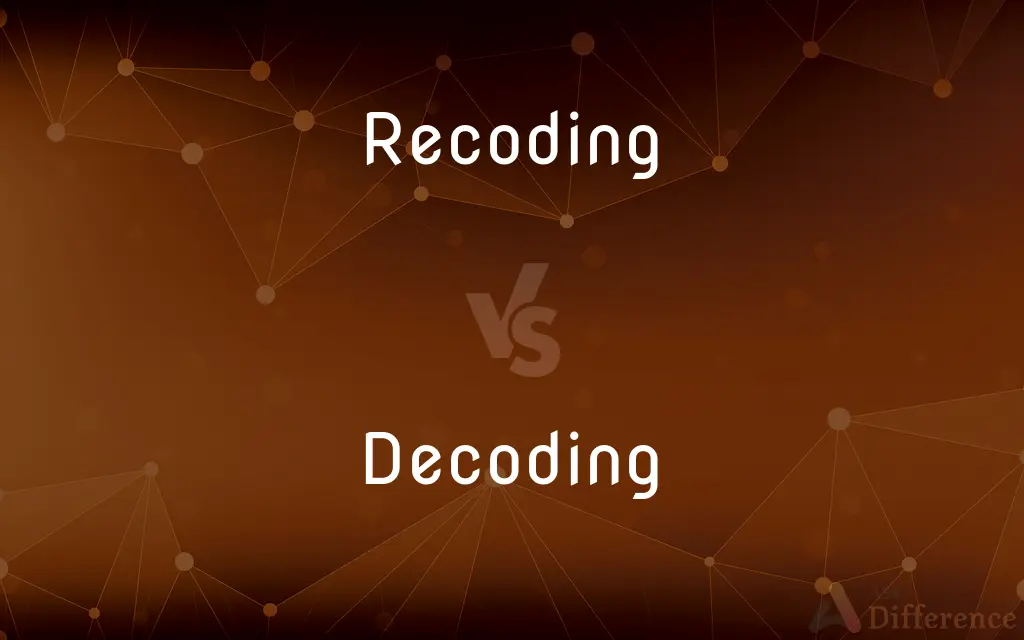Recoding vs. Decoding — What's the Difference?
By Fiza Rafique & Maham Liaqat — Updated on March 21, 2024
Recoding involves altering data's format or structure, maintaining its essence, while decoding translates encoded data back to its original form.

Difference Between Recoding and Decoding
Table of Contents
ADVERTISEMENT
Key Differences
Recoding and decoding are both crucial in data handling, but serve different functions. Recoding is the process of changing the format or structure of data without altering its core meaning. This is often done to make data compatible with different systems or to simplify its analysis. For example, recoding might involve converting gender data from 'Male/Female' to 'M/F' to standardize dataset formats. On the other hand, decoding is the act of translating encoded or encrypted data back into its original form. This is common in data transmission and storage, where data is encoded to ensure privacy or to compress it for easier handling. Decoding is necessary to retrieve the original information from the encoded data, such as converting base64 encoded images back to their original binary format.
Recoding is usually applied for data standardization, optimization, or preparation for analysis, involving format or value transformation without losing information. It’s often used in data science to prepare datasets for machine learning models, ensuring that all data adheres to a consistent format for better algorithm performance. Whereas, decoding is essential in communications and data storage, focusing on restoring data to its original, understandable state after being encrypted or compressed. This is critical for secure data transmission over the internet, where data is encoded to protect it from unauthorized access.
In the context of computer programming, recoding might involve converting data types or restructuring databases to improve efficiency or compatibility with different programming languages. It’s a strategic step in software development and database management, aiming at optimizing system performance. Decoding, on the other hand, is key in data interchange between systems, enabling the interpretation of data formats like JSON, XML, or proprietary encryption formats, making interoperability possible between diverse systems and platforms.
Recoding can also refer to the process of categorizing or reclassifying data to fit new analytical frameworks or criteria, such as redefining age groups in demographic studies. This allows researchers to analyze data in ways that are more relevant to their specific questions or hypotheses. Decoding, by contrast, often involves cryptographic methods to ensure data security and privacy, such as SSL/TLS for secure web browsing, where data sent between the browser and server is encoded and must be decoded at the receiving end.
Recoding is an essential step in data preprocessing, enhancing data quality and consistency for analytical models or system integration. It ensures that data from various sources can be effectively combined and analyzed. Decoding ensures data transmitted across systems or stored in compressed formats remains accessible and usable, safeguarding information integrity and confidentiality.
ADVERTISEMENT
Comparison Chart
Purpose
Alter data format without changing meaning
Translate data back to original form
Application
Data standardization, machine learning
Data transmission, encryption
Process
Format/value transformation
Encryption/compression reversal
Context
Data analysis, system optimization
Secure communication, data storage
Outcome
Enhanced data consistency
Original data retrieval
Compare with Definitions
Recoding
Data preparation and analysis.
Recoding data before analysis ensures uniformity and reduces potential errors.
Decoding
Converting encoded or encrypted data back to its original form.
Decoding a base64 string can retrieve the original image file.
Recoding
Simplifying or standardizing data for processing.
Recoding a dataset's categorical variables into dummy variables can facilitate statistical modeling.
Decoding
Restoring data for readability or further processing.
Decoding a URL encoded string is essential for web applications to process user inputs correctly.
Recoding
Involves format change or categorization.
Recoding a variable involves changing its values from one form to another, like from names to IDs.
Decoding
Reversing encryption or encoding mechanisms.
Decoding encrypted data requires the correct key to retrieve the original information.
Recoding
Altering the format or structure of data while preserving its content.
Recoding survey responses from textual descriptions to numerical codes enhances data analysis efficiency.
Decoding
Secure data transmission and storage.
Decoding SSL/TLS encrypted data is necessary for secure internet browsing.
Recoding
Consistency and compatibility in data.
Recoding ensures that data from different sources can be integrated smoothly for analysis.
Decoding
Accessibility and integrity of data.
Decoding ensures that compressed or encrypted data can be used as intended.
Recoding
Present participle of recode
Decoding
To convert from code into plaintext.
Recoding
The act or result of coding again or differently.
Decoding
To convert from a scrambled electronic signal into an interpretable one.
Recoding
Converting from one code to another
Decoding
To extract the underlying meaning from
Decode a complex literary text.
Decoding
An instance of the translation of something into a form more suitable for subsequent processing.
Decoding
Present participle of decode
Decoding
The activity of making clear or converting from code into plain text;
A secret key or password is required for decryption
Common Curiosities
What is recoding in data analysis?
Recoding in data analysis involves changing the format or values of data without altering its fundamental meaning, often to prepare it for statistical modeling.
Why is decoding important in communication?
Decoding is crucial in communication to ensure that encrypted or encoded data can be translated back to its original, understandable form, maintaining data integrity and confidentiality.
Is recoding necessary for machine learning?
Recoding is often necessary in machine learning to transform categorical data into a format that algorithms can process effectively, such as converting to numerical values.
What's the difference between encoding and decoding?
Encoding transforms data into a different format or structure for secure transmission or storage, while decoding reverses this process, restoring the original data.
Is recoding similar to data cleaning?
Recoding is a part of data cleaning, focusing specifically on altering data formats or values for consistency and compatibility, whereas data cleaning may involve broader tasks like removing errors or duplicates.
Can recoding affect data quality?
If done correctly, recoding improves data quality by standardizing and simplifying it for analysis, without losing important information.
How does decoding work with encrypted data?
Decoding encrypted data requires a decryption key or algorithm to revert it to its original state, ensuring that only authorized parties can access the information.
Can decoding be automated?
Decoding can be automated, especially in computer systems where algorithms decrypt or convert encoded data back to its usable form without manual intervention.
Can all data be recoded or decoded?
Most data can be recoded or decoded with the right tools or algorithms, but the specific methods depend on the data's format and the purpose of the transformation.
What are the risks of improper decoding?
Improper decoding can result in data corruption, loss of information, or breaches of privacy and security if sensitive data is inadvertently exposed.
Why might recoding be used in database management?
Recoding in database management can optimize storage and improve query performance by standardizing data formats and simplifying complex data structures.
How do compression and decoding relate?
Compression reduces data size for efficient storage or transmission, and decoding is the process of restoring compressed data to its original form.
How does decoding facilitate data interoperability?
Decoding allows different systems and applications to interpret and use data correctly, enabling interoperability by converting data to a universally understandable format.
Share Your Discovery

Previous Comparison
Capellini vs. Spaghettini
Next Comparison
Scissors vs. TongsAuthor Spotlight
Written by
Fiza RafiqueFiza Rafique is a skilled content writer at AskDifference.com, where she meticulously refines and enhances written pieces. Drawing from her vast editorial expertise, Fiza ensures clarity, accuracy, and precision in every article. Passionate about language, she continually seeks to elevate the quality of content for readers worldwide.
Co-written by
Maham Liaqat













































